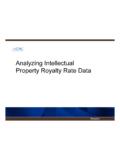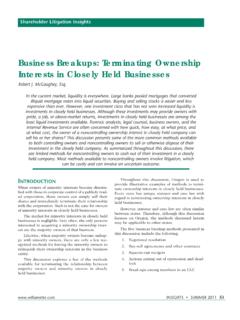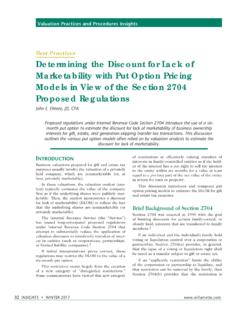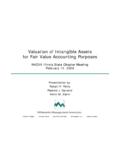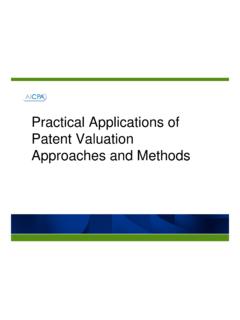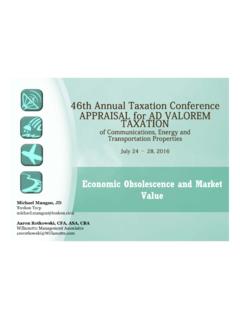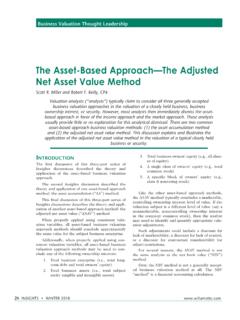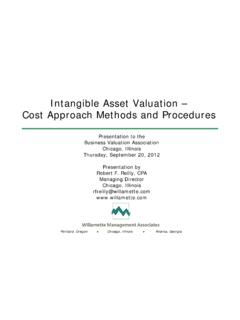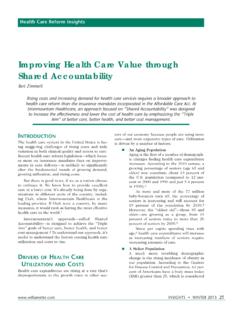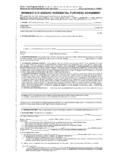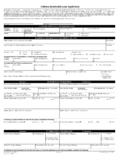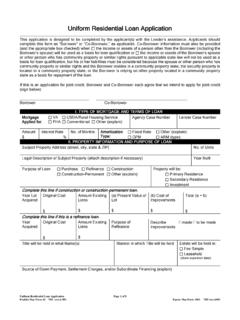Transcription of Valuing Real Estate Fractional Ownership Interests
1 80 INSIGHTS SUMMER 2010 www .willamette .comValuing real Estate Fractional Ownership InterestsKatherine A. Gilbert and C. Ryan StewartIntangible Asset Valuation Insights Intangible asset valuation analysts are often called on to perform fair market value valuations of real Estate undivided Ownership Interests (also called Fractional Ownership Interests ). Many of these real Estate undivided Interests are owned by holding companies or by high net worth individuals. Accordingly, those real Estate Fractional Ownership Interests may need to be valued for federal gift or Estate tax compliance purposes or for intergenerational wealth transfer and Estate planning purposes. This discussion provides an explanation of the defining characteristics of real Estate Fractional Ownership Interests . And, this discussion introduces (1) the valuation approaches and methods, (2) the relevant judicial precedent, and (3) the investment risk and expected return factors that the intangible asset valuation analyst should consider when Valuing these types of Fractional Ownership is A Fractional Ownership interest ?
2 A real Estate Fractional Ownership interest , also called a tenancy in common interest , exists when two or more co-tenants each own a separate frac-tional share of undivided real property. For purposes of this discussion, the terms Fractional Ownership interest and undivided Ownership interest are used a joint tenancy Ownership , there is no right of survivorship among tenants in common. A tenancy in common requires only the unity of pos-session of the subject real the absence of an agreement between the co-tenants, each co-tenant may possess and enjoy the entire real Estate . For example, each co-ten-ant has the right to use and to enjoy a share of the property s each co-tenant has an equal right to possess and enjoy the real Estate , he or she cannot:1. exclude the other co-tenants or2. designate any portion of the real Estate as his or her the case of a single-family home, or any other type of residential property that can not be subdi-vided, each co-tenant s right to use and enjoy the real Estate can create potential Ownership Interests often result when partners ( , business or family partners) acquire the real Estate without (1) the use of a holding company entity structure or (2) the transfer of the property between family their very nature, real Estate Fractional own-ership Interests typically suffer from the following valuation influences:1.
3 A lack of marketability2. a lack of Ownership controlproperty-speciFic FActors to consider in the vAluAtion AnAlysis1. Co-Tenant Rights, Privileges, and Obligations under State Partition A co-tenant typically may compel a partition of the subject real Estate . When the subject real Estate is www .willamette .com INSIGHTS SUMMER 2010 81partitioned, then each co-tenant takes a distinct part according to his or her respective Ownership interest . The purpose of a partition is to allow the tenants in common to sever their Ownership Interests . The partition enables each tenant to take possession, enjoy, and improve his/her separate real Estate parcel at his or her own pleasure. If, because of its physical nature, the subject real Estate cannot be equitably divided in-kind, then:a. the entire property may be ordered by a court to be sold andb. the entire property sale proceeds may be ordered to be divided among the Conveyance and Sale Tenants in common each hold separate owner-ship Interests .
4 These separate owner-ship Interests can be sold, conveyed, or transferred without the consent of the other Fractional interest owners. One tenant in common cannot bind his/her nonconsenting co-tenants in any disposition of their undivided interest in the common real Contribution and Costs Each co-ten-ant also has a right to a contribution from his/her co-tenants. For example, each co-tenant is responsible for the costs associated with his or her co-tenancy interest , including real Estate taxes and property Written Agreement of Co-Tenancy. The greater the number of co-tenants own-ing a piece of the property, the greater the potential for conflict in deciding how the property should be managed. Many potential conflicts between the co-tenants could be avoided if the co-ten-ants executed an agreement that describes how the real Estate will be used or Debt Obligations.
5 A hypothetical buyer of a real Estate undi-vided Ownership interest typically would consider whether the subject property was encumbered by a mortgage loan. In addi-tion, the hypothetical buyer typically would be concerned with:n whether the co-tenants are jointly and severally liable for the debt obligation,n whether the debt obligation is assum-able by the buyer of an undivided own-ership interest ,n whether the partition of the property or a sale of an undivided Ownership inter-est in the property results in the call of the debt obligation, andn whether the holder of an undivided Ownership interest is at risk of losing his or her interest if the lender fore-closes on the subject Ability to Subdivide the real Estate . A hypothetical buyer of a real Estate undi-vided interest would generally prefer an interest in a parcel of land that is capable of being subdivided rather than in a parcel of land that is not capable of being Historical Sales of Undivided Interests .
6 Although uncommon, any history of arm s-length sales of undivided Interests of the subject property may be relevant to the valuation Restrictions on Transferability of an interest . Any restrictions on the transferability of the subject property may be relevant to the valuation Lack of Income to Cover Expenses. The valuation analyst should consider the income-producing capacity of the subject real Estate . The valuation analyst should also consider whether there is sufficient property income in order to cover the real Estate property tax and other operating Accepted vAluAtion ApproAches And MethodsThere are two valuation approaches and methods that valuation analysts commonly use to value a real Estate Fractional Ownership interest :1. the market approach and the sale transac-tion analysis valuation method2. the income approach and the partition analysis valuation methodMarket Approach The Sale Transaction Analysis MethodThis market approach valuation method is based on a comparison of the subject Fractional interest to published studies of empirical data regarding arm s-length sales of Fractional INSIGHTS SUMMER 2010 www.
7 Willamette .comFirst, the valuation analyst obtains a valuation of the fee simple interest in the subject real Estate from an independent real Estate appraiser. Second, the valuation analyst reviews:1. the subject property s physical and eco-nomic characteristics and2. the relevant real Estate property-related and market-related fac-tors are typically described in the real Estate appraisal report and in other publicly available , this stage of the Fractional interest valu-ation analysis is typically presented as a simple adjusted net asset value (ANAV) indication. That is, the subject real Estate fee simple value indication is adjusted for:1. any outstanding mortgages or2. other conclusion of the fee simple interest value minus outstanding mortgage/other encumbrance amount is the real Estate , the valuation analyst will compare:1.
8 This subject real Estate ANAV value indica-tion to2. published studies of empirical data on real Estate undivided interest actual sale this procedure, the valuation analyst fits the subject property into the published empirical sale data. This comparison of subject real Estate to sale transaction data allows the analyst to select a property-specific undivided interest valuation price property-specific but market-derived valua-tion price discount typically reflects the combined price adjustments related to: (1) a discount for lack of control (DLOC) and (2) a discount for lack of marketability (DLOM).Exhibit 1 Fair Market Value of the Subject Fractional Ownership InterestMarket ApproachSale Transaction Analysis Valuation MethodSimplified Illustrative ExampleAs of December 31, 2009 Name of the Subject Property1544 County Highway The Villas at Santa Rosa BeachDescription of the Subject PropertyType:Residential CondominiumLocation:Santa Rosa Beach, FLYear Built:1998 Property Tax Assessment Value:$949,850for the 2009 Tax YearMost Recent Sale of the Subject PropertyNoneas of December 8, 2009 ValueUndivided interest Fair Market Value EstimationIndicationIndicated Fee Simple interest Market Value of the Subject Property [a]850,000$Times: Subject Undivided interest Ownership .
9 Indicated Pro Rata Value of the Subject Undivided Ownership interest (Before any Valuation Price Adjustment)383,333 Selected Valuation Price Adjustment for the Subject Undivided Ownership interest at 22% [b](84,333)Indicated Fair Market Value of the Subject Undivided Interest299,000$Indicated Fair Market Value of the Subject Undivided interest (rounded)300,000$Notes:[a]Based on a market value fee simple interest real Estate appraisal of the subject property by the Accurate Appraisal Company as of December 31, 2009.[b] Based on the valuation analyst's comparative assessment of the published empirical evidence of real Estate Fractional interest sale transactions that indicate typical price discounts within a range of between 15% and 35%. Several of these published studies of empirical sale transaction data are summarized in the Sale Price Discount Empirical Data section of this .willamette.
10 Com INSIGHTS SUMMER 2010 83 Exhibit 1 illus-trates a simplified example of this mar-ket approach sale transaction analysis valuation method. This valuation meth-od and this sim-plified illustrative example are based on the analysis of published empiri-cal real Estate frac-tional interest sale transaction Approach The Partition Analysis MethodThe second gener-ally accepted valu-ation method for a real Estate undivid-ed Ownership inter-est is an income approach valuation this valuation method, the valu-ation analyst will quantify the expect-ed costs ( , out-of-pocket expenses and inves-tor opportunity cost) to partition the subject real real Estate partition cost analysis typi-cally includes two cost components. The first cost component is the cost to bring a real Estate partition lawsuit.
